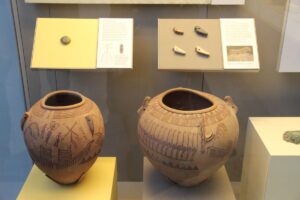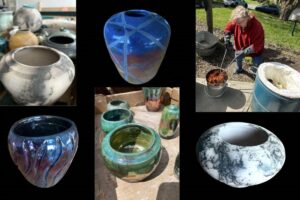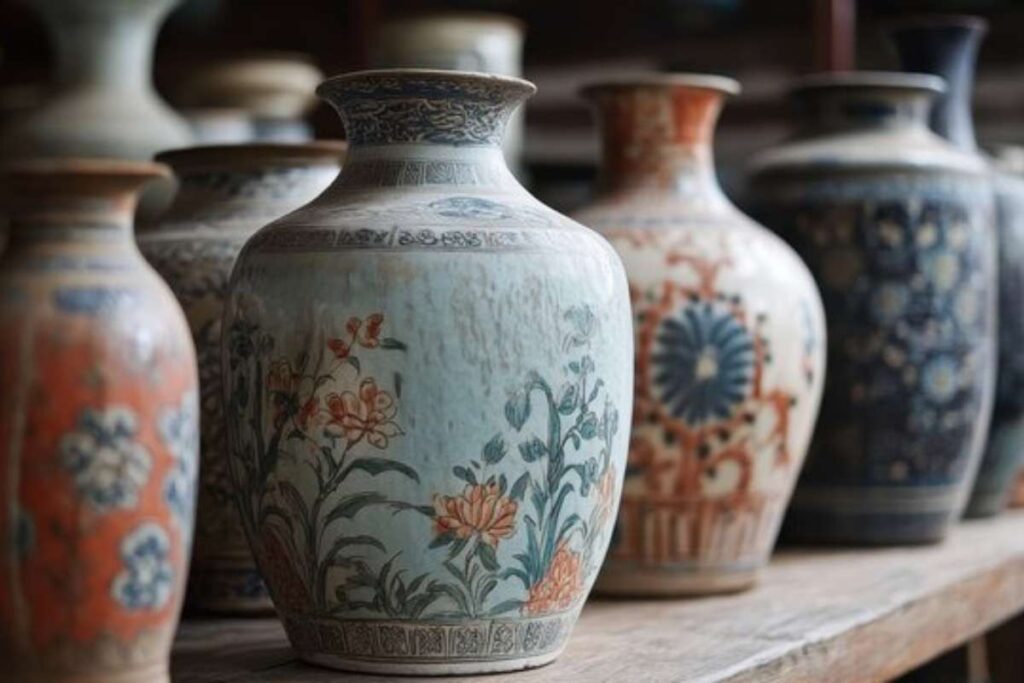
Ancient Chinese pottery is one of the most significant artifacts that paints a picture of Chinese culture throughout the centuries. It reflects on the evolution of Chinese civilization, advancements, and different periods from the artist’s perspective.
Ancient Chinese pottery is widely admired today for its intricate beauty and historical significance. These ceramics have long been collectors’ items.
These ancient crafts were more than just beautiful pieces of ceramics; they were mostly made as everyday items. These ceramics were made with techniques and styles that were so influential that many other cultures started using them, and some are still prevalent to this day.
In this article, I’ll explore this ancient craft, its origin history, techniques used, its role in trade, its evolution, and global influence through the ages.
Table of Contents
The Origins of Chinese Pottery
Neolithic Period (10000-2000 BCE)
The earliest forms of pottery in the Chinese peninsula date back to the Neolithic period. These ceramics were handmade and primarily functioned as storage for food and water. By no means were they embedded with intricate artistic motifs like the later forms of pottery that evolved from these, however.
They involve designs within them, though they are simplistic motifs like bold solid colors and geometric patterns. These designs have emerged during the late stages of the period. And the evolution can be easily divided into separate phases. Here are the two most noticeable divides:
Yangshao Culture (5000-3000 BCE)
Often referred to as the “Painted-pottery”, it originated around 500 BCE in the Yellow River basin. This era of pottery is signified by its paints and motifs.
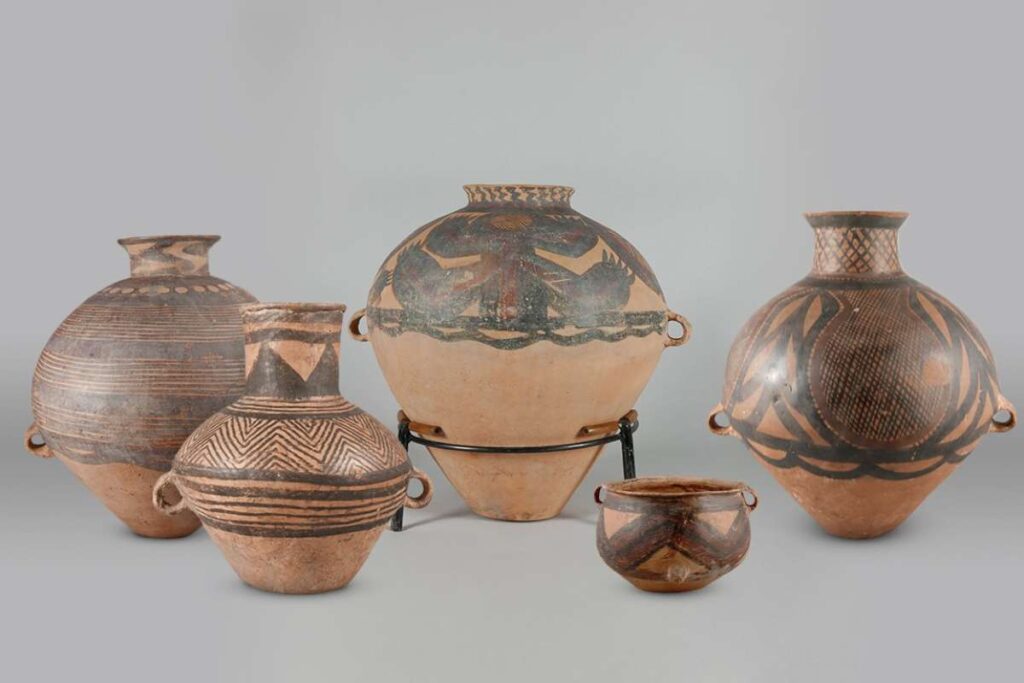
This being the earliest form of pottery in ancient China, gave it some unique traits that draw a clear divide between the later forms of the art. These potteries were both an everyday necessity and ceremonial vessels.
Here’s a list containing the key characteristics include:
- Distinctive painted designs
- Geometric motifs
- Stylized Animal and human motifs
- Distinct shapes
- Techniques like Hand-coiling, glazing/ varnishing without wheels
Longshan Culture (3000-1900 BCE)
This era was the heir to the Yangshao pottery, emerging from the same region gave them a history of innovative artistry. This era’s pottery holds a significant regional influence, as these potteries were more than mere utensils.
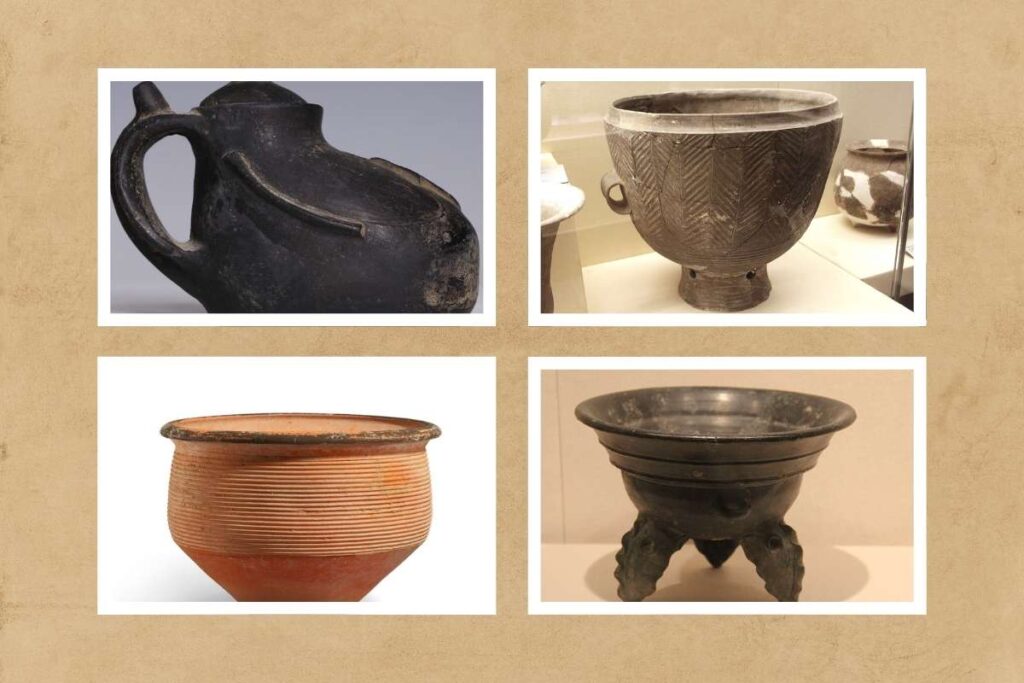
Longshao pottery was intricately made. Their expertly crafted pots were so thin that they rang like a bell upon tapping. This trait, combined with the paint choices, led to them being known as “Eggshell pottery.” This kind of pottery is found mostly around the Yellow River in China.
Here are a few defining features of the pottery from the Longshan culture:
- Solid bold colors, specifically Black and white
- Bulging or other dramatic shapes
- Fast-turning wheels allowed for bold designs with very thin walls (which earned them the name Eggshell-pottery)
- Firing and carbonization processes gave them their signature black color
6 Famous Ancient Chinese Pottery Styles
Chinese history is as old as time. Through the centuries, many cultures have emerged and faded. With each era came new artistic expressions and trends. Keeping up with the visions of the eras throughout different dynasties, ancient Chinese pottery has gone through a lot of changes.
Here are a few notable periods and their pottery’s defining features:
Shang and Zhou Dynasties (1600–256 BCE)
This era is mainly defined as the Bronze era of ancient China. Naturally, they reflected similar artistic choices reflecting their Bronze Revolution.
The Shang dynasty marked the beginning of the Bronze era. With new technologies came new techniques, spearheading a cultural shift. Techniques like ash-glazing were popular for ceremonial purposes, and other types of hard-bodied, high-fired pieces were also crafted for more regular usage.
Then the Zhou followed suit. They perfected the existing techniques like ash-glazing and styles, and at the same time, introduced newer, more influenced artistic choices. These were mostly hard stoneware, as opposed to the softer vessels of the Shang dynasty. These deliberate choices led to the proto-porcelain era of ancient Chinese pottery.
These are the prominent features of ancient Chinese pottery from these two dynasties:
- The Shang Dynasty saw the emergence of bronze-influenced pottery with intricate carvings.
- Techniques like the ash-glaze (a.k.a. Proto celadon) began to appear during the Shang dynasty.
- The Zhou Dynasty introduced early glazing techniques, enhancing durability and aesthetics.
- Popularization of stoneware during the Zhou Dynasty.
Han Dynasty (206 BCE – 220 CE)
Chinese pottery reached new heights in variety and purpose during the Han Dynasty. Mass production techniques using molds and kilns became widespread, leading to intricate ceramic tomb figurines, vessels, and architectural models. Glazed earthenware, especially the green lead-glazed ‘Han ware,’ became common in burial practices.
Here are a few key characteristics of Han Dynasty pottery:
- Han tombs were often filled with ceramic replicas of servants, animals, and even mini-houses, meant to serve the deceased in the afterlife.
- Some tomb figures were crafted with movable limbs, showing an early understanding of articulation in sculpture.
- Lead-glazed earthenware became popular.
- Tomb figurines (ming qi) were crafted to accompany the deceased in the afterlife.
Tang Dynasty (618–907 CE)
The Tang dynasty was a golden age for Chinese pottery, famous for its vibrant sancai (“three-color”) glazed ceramics.
Using lead-based glazes in amber, green, and cream, artisans created dynamic figures of horses, camels, and court ladies, often buried in tombs to reflect the empire’s cosmopolitan spirit.
These are the basic features that ruled the pottery world during this era:
- The Tang Sancai style was influenced by the Silk Road trade—many figurines depict Central Asian features and attire
- The iconic Tang horses weren’t just for show; they symbolized power and prestige, often portrayed mid-stride with exaggerated expressions.
Song Dynasty (960–1279 CE)
This era truly showed a shift in taste as artisans moved slightly away from detailed motifs to simpler designs. The Song dynasty elevated Chinese ceramics to refined artistry, emphasizing simplicity, subtle glazes, and perfect form.
Famous kiln styles like Ru, Guan, Ge, Ding, and Jun produced serene pieces in pale blues, celadons, and ivory whites, often with crackled glaze that became part of the aesthetic.
Major styles included:
- Ru ware – Celadon-glazed pottery, highly prized for its soft green hues.
- Guan ware – Crackled glaze, often used in imperial collections.
- Ding ware – White porcelain with carved designs.
These distinct styles became widely popular throughout China. Especially Ru was so prized that, only a few hundred pieces survive to this day. It didn’t stop there as the understated elegance of Song ceramics later inspired generations of scholars and Zen artists across East Asia.
Ming Dynasty (1368–1644 CE)
The Ming Dynasty brought about another cultural shift that left its impression on the pottery of the era. These pottery are iconic for blue-and-white porcelain, fired at high temperatures using cobalt pigment imported from Persia, on fine white clay.
These had intricate designs of dragons, florals, waves, etc, were boldly painted intricately with cobalt on the white canvas. These pottery had strict quality control, to the point where defects were smashed on the spot.
These porcelain crafts became so popular that Jingdezhen became the porcelain capital, exporting exquisite pieces globally.
Qing Dynasty (1644–1912 CE)
The Qing dynasty (1644–1912 CE) saw porcelain reach peak technical and artistic sophistication. Under emperors like Kangxi, Yongzheng, and Qianlong, potters mastered both vivid famille rose enamels and delicate monochromes. Jingdezhen continued as the imperial kiln hub, producing highly detailed, luxurious wares.
Interesting tidbits about this dynasty’s pottery:
- Qianlong-era pieces often featured hidden poems or imperial marks in tiny, perfect script—sometimes only visible under magnification.
- Some vases from this era sold for millions in modern auctions, including one found in a London attic that fetched over $80 million!
Key Styles and Techniques in Ancient Chinese Pottery
Chinese pottery was a significant aspect of the socio-economic life of ancient China. They were everywhere, from daily use to international trade, and held weight during ceremonial occasions as well.
Here are a few defining features signifying its role in different aspects of Chinese life:
Types of pottery
| types | Characteristic | Usage |
| Earthenware | Porous, low-fired clay | Storage, cooking, ritual uses |
| Stoneware | High-fired, durable ceramics, glazed | Mostly ceremonial purposes |
| Porcelain | White, translucent appearance | Ceremonial, decorative, and trade |
These were prevalent in different eras throughout the different dynasties, with earthenware being the earliest form, and porcelain the latest of the ancient Chinese pottery.
Glazing and Firing Techniques
Dynasties throughout Chinese history used different methods to create pottery, which gave them the signature looks historians associate them with.
Here are a few examples of that:
- Celadon glaze: Greenish tint due to iron oxide.
- Sancai (Three-Color) glaze: Popular in Tang pottery, featuring yellow, green, and brown.
- Qingbai glaze: Pale blue glaze popular in the Song dynasty.
- Underglaze blue: Used in Ming and Qing porcelain, creating vivid patterns.
Molded vs. Hand-Painted Designs
Although hand-painted crafts ruled China, when it came to daily use that needed mass production, molded ceramics were the go-to.
Here’s the breakdown:
Molded
Molded pottery involves pressing clay into pre-carved molds to create uniform shapes or decorative patterns.
This method became widespread during the Han dynasty, especially for tomb figurines and architectural models.
It allowed for the mass production of complex shapes, like guardian figures, animals, or miniature houses, with consistent detail.
In the Tang and Ming dynasties, molds helped create elaborate relief patterns on vessels and figurines, often later finished with colorful glazes.
Hand-painted
Hand-painted pottery showcases the artistic freedom and brushwork mastery of individual artisans.
Early examples include the Yangshao culture’s red pottery with bold black geometric or animal motifs, painted by hand with natural pigments.
The Ming dynasty elevated this art with cobalt-blue underglaze painting—featuring flowing dragons, waves, florals, and narrative scenes—all hand-painted before firing.
Even in mass-production periods, imperial kilns often reserved hand-painting for elite commissions.
No two hand-painted pieces are truly identical. Each brushstroke tells the story of the artist’s hand and moment of creation, giving it the value it deserves.
Cultural and Religious Significance of Pottery
Ancient Chinese pottery was invented for daily use. But over time, this craft evolved into much, much more.
Usage other than household necessity is prohibited:
- Funerary Customs: Pottery figurines and vessels were buried with the dead for use in the afterlife.
- Imperial Collections: Ming and Qing emperors amassed vast collections of fine porcelain.
- Symbolism:
- Dragons – Power and imperial authority.
- Phoenixes – Prosperity and rebirth.
- Lotus flowers – Purity and spiritual enlightenment.
The Global Influence of Ancient Chinese Pottery
Ancient Chinese pottery was held in very high regard for its intricate designs, vibrant colors, and excellent craftsmanship.
The Ming wares were most admired worldwide. Even now they auction for millions. Song pottery was adopted by the Zen culture and is still in trend with the culture.
These potteries were so popular that they traveled all the way to Africa via the Silk Road.
Here are a few examples:
- Impact on East Asia: Chinese ceramics influenced Japanese and Korean pottery, leading to the development of unique styles like Korean celadon and Japanese Imari ware.
- European Adoption:
- Dutch Delftware imitated blue and white porcelain.
- The Meissen porcelain factory in Germany was inspired by Chinese techniques.
- Trade on the Silk Road: Chinese pottery was exported as far as Persia, Egypt, and even Africa.
Preservation and Modern Appreciation
Ancient Chinese pottery has a wide variety of different styles, motifs, and techniques involved, making them one of the most versatile pieces of art. Museums and collectors across the world adore pottery from different dynasties throughout Chinese history. These potteries are no mere artifacts, but timeless expression of Chinese artistry.
Let’s break it down a little:
Famous Museums and Collections
These are the biggest collections of ancient Chinese pottery:
- The Palace Museum, Beijing – Once the Forbidden City, this museum holds an unparalleled trove of imperial ceramics, including rare Ming and Qing dynasty porcelain used by emperors and nobility.
- The British Museum, London – Home to one of the most comprehensive collections of Chinese ceramics, showcasing everything from Neolithic Yangshao painted wares to refined Qing enameled porcelain.
- The Metropolitan Museum of Art, New York – Features exquisite Tang sancai figures and Song monochromes, offering a visual journey through centuries of ceramic evolution.
The Market for Antique Chinese Pottery
Although museums have the biggest collection of Chinese pottery, they are revered as collectors’ items across global markets.
- Auction houses like Sotheby’s and Christie’s frequently auction imperial Ming and Qing porcelain, with individual pieces sometimes fetching tens of millions of dollars.
- Authentication techniques such as thermoluminescence dating and kiln–site analysis are used to ensure the legitimacy of valuable artifacts.
Collectors especially prize works with known provenance, unique imperial marks, or rare glazes, such as Ru ware from the Song dynasty or Qianlong-era Famille Rose porcelain.
Modern Rival and Influence
Chinese pottery were so influential, it dominated the entirety of Asia and Europe, and artists across the world working in any medium still draw inspiration from them. These potteries were the building blocks of Chinese culture and art.
Here are two examples of that:
- Ancient glazing methods—like Tang sancai, Song celadon, and Ming cobalt blue—are reimagined in modern forms.
- In China and beyond, workshops in places like Jingdezhen continue to produce porcelain using centuries-old methods, blending innovation with heritage.
Conclusion
Ancient Chinese pottery is a testament to China’s rich artistic and cultural heritage. From the Neolithic Yangshao pottery to the refined Ming and Qing porcelain, Chinese ceramics have influenced global art and trade for centuries.
These porcelains remain a symbol of luxury, with modern creators honoring the past while pushing artistic boundaries. From high-end design studios to global art fairs, remnants of Yangshao hand-painted pottery and Longshan eggshell-thin ware can still be seen.
Humans have shown a drive to create something beautiful, to leave a mark of the with something influential, ever since its beginnings. Ancient Chinese pottery is one of the best examples of that. These pieces show their life, superstitions, warfare, politics, and whatnot.
Collectors all across the world adore ancient Chinese pottery. Museums have large collections of them in and outside of China. Various Auction houses often hold events surrounding these crafts, and they sell for millions. This goes to show how, millennia later, this ancient art still affects humans.
Frequently Asked Questions
1. Why is ancient Chinese pottery valuable?
Because of its beauty, craftsmanship, historical importance, and rarity, especially pieces from imperial dynasties like the Ming and Song.
2. How is authenticity verified?
Through methods like thermoluminescence dating, kiln analysis, and checking for known marks or provenance.
3. What’s the difference between molded and hand-painted pottery?
Molded pottery uses forms for shaping and decoration; hand-painted pieces are decorated by brush, making each one unique.
4. Why is Jingdezhen famous?
It was the center of imperial porcelain production for centuries, known for top-quality and innovative designs.
5. How do modern artists use ancient techniques?
They adapt traditional glazes, forms, and motifs into new, contemporary ceramic works.

Hi,
I’m Mashrafe, an experienced writer specializing in writing compelling marketing copies, blogs, product reviews, and guides. I have a knack for crafting engaging articles across a wide variety of topics that are designed to grab attention and drive results. Whether it’s the latest gadgets, beauty products, or niche industry services, I bring a unique perspective that is as interesting as it is informative. So buckle up as I guide you through the world of new trends and tech innovations that will blow your mind.
